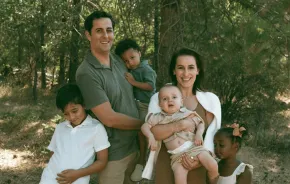
Photo:
iStock
History of Montessori education
When physician Maria Montessori first began working with orphans in rural Italy, she found that certain resources and the way in which she organized her classrooms made it easier for children to develop important skills.
Through experimentation and careful analysis, she was able to develop materials and organize her classrooms in a way that helped kids grasp even the most difficult concepts.
Montessori based her educational philosophy on specific principles: active learning, experimentation, critical thinking, day-dreaming and invention.
Today, Montessori-inspired approaches revolve around these principles and can help guide you in creating a Montessori-style playroom.
Here are five principles — and accompanying toy ideas — to assist you when setting up a Montessori-style playroom.
1. Accessibility
“Help me to help myself” is one of Montessori’s best-known quotes, and it clearly reflects one of her guiding principles.
Montessori believed that children should be allowed to engage with whatever was of interest to them, for as long as they desired. It is therefore important for them to be able to access their play objects by themselves. This is why many Montessori-style playrooms feature kid-level shelving that allows you to easily display all of your child’s toys.

2. Purposefulness
Montessori-inspired toys are not just about distraction; their main purpose is to promote engagement and to help your child develop specific skills, such as fine and gross motor skills, or spatial and visual discrimination skills.
This Montessori Busy Board is designed to help a child develop fine motor skills and understand how things work, while allowing kids to correct their mistakes by themselves. The Wooden Wobble Balance Board can help them develop a sense of balance and work on their gross motor skills.
Good-quality, wood stacking toys are common in Montessori-style playrooms because they help children to practice their creativity and to work on their fine motor skills.

3. Simplicity
Montessori believed in simplicity, both in terms of simple toys and minimal distraction. She believed that less mess led to greater learning.
Proposing a limited number of toys and activities is an easy way to follow Montessori principles in your playroom. This increases engagement by limiting distraction. If your child has too many toys, consider selecting approximately six toys at any given time, then rotate them occasionally. While it is important to choose different toys to enable your child to work on different skills, being attentive to their interests and their actual capacities can help you determine the best toys for them.
For example, if they appear to struggle with a given activity, put it away and have them try it again a few weeks later. Or if they show an interest in stacking toys, set out different types of stacking toys to increase their engagement.
Limiting the number of toys also frees up space in your child’s Montessori-style playroom, and open space is important because it allows kids to move around more freely.
Having an open space can also allow you to install important developmental toys, such as Pikler triangles, which will help them develop their gross motor skills. And if you choose a wooden climbing triangle, your child can play with it for years!

4. Open-endedness
One of the key principles of Montessori education is that children should be provided with open-ended toys and activities, meaning those that enable them to use the same resources in many different ways.
Open-ended toys encourage your child to use their imagination and develop their creativity and critical-thinking skills. Wooden blocks are a good example of a simple, open-ended Montessori-inspired toy. Kids love durable wooden blocks such as Tegu magnetic wooden blocks. Kids can use them to learn about colors and shapes, or build anything that they can imagine!
Balance bikes such as the Bobike Baby Balance Bike also make great open-ended toys. These bikes teach kids about balance, coordination and spatial awareness.

5. Ordered
In a Montessori-style playroom, each object has its own place, and the objective is to allow your child to choose their toys and activities — then put them back in the same spot — by themselves.
The best Montessori-style playroom is one that encourages your child to actively participate in their learning through exploration, engagement, and trial and error. The key to making it work is to select a variety of activities that align with your child’s interests and development and that will help them practice different skills.
Montessori education is about more than providing toys and activities; it is about making the most use of your child’s environment to help them participate as fully as possible in your family life. The following ideas could help with this:
- Provide kids with a child-size broom and dustpan set to help them participate more readily and easily in age-appropriate chores.
- Install low shelves in your home to make it easier for your child to participate in everyday household chores such as setting the table or putting away dishes.
- Use a standing tower to make it easier for them to reach the countertop, sink or the dinner table by themselves and to encourage their participation in everyday life.

Editor’s notes: This article was originally published in 2023 and was updated in August 2024 by ParentMap’s senior editor with additional resources.
This article contains affiliate links. If you purchase products through links on our site, ParentMap may earn an affiliate commission.











